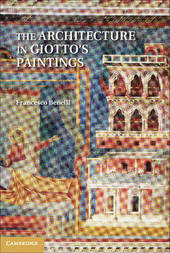
|
The Architecture in Giotto's Paintings
Hardback
Main Details
| Title |
The Architecture in Giotto's Paintings
|
| Authors and Contributors |
By (author) Francesco Benelli
|
| Physical Properties |
| Format:Hardback | | Pages:300 | | Dimensions(mm): Height 260,Width 185 |
|
| Category/Genre | Byzantine and medieval art c 500 CE to c 1400
Painting and paintings
Individual artists and art monographs |
|---|
| ISBN/Barcode |
9781107016323
|
| Classifications | Dewey:759.5 |
|---|
| Audience | | Postgraduate, Research & Scholarly | |
|---|
| Illustrations |
10 Plates, color; 108 Halftones, unspecified
|
|
Publishing Details |
| Publisher |
Cambridge University Press
|
| Imprint |
Cambridge University Press
|
| Publication Date |
12 December 2011 |
| Publication Country |
United Kingdom
|
Description
This book offers an analysis of Giotto's painted architecture, focusing on issues of structural logic, clarity of composition, and its role within the narrative of the painting. Giotto was the first artist since antiquity to feature highly-detailed architecture in a primary role in his paintings. Francesco Benelli demonstrates how architecture was used to create pictorial space, one of Giotto's key inventions. He argues that Giotto's innovation was driven by a new attention to classical sources, including low reliefs, mosaics, mural paintings, coins, and Roman ruins. The book shows how Giotto's images of fictive buildings, as well as portraits of well-known monuments, both ancient and contemporary, play an important role in the overall narrative, iconography, and meaning of his works. The conventions established by Giotto remained at the heart of early modern Italian painting until the sixteenth century.
Author Biography
Francesco Benelli is Associate Professor of Renaissance Architecture in the Department of Art History and Archaeology at Columbia University. He was the recipient of the Mellon Postdoctoral Fellowship at Columbia University and a Fellow at the Kunsthistorisches Institut in Florence. He has published widely on several aspects of Renaissance architecture, as well as on issues of building material and technique and the history of design and construction.
Reviews'Benelli argues well ...' The Art Newspaper
|